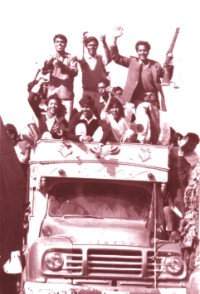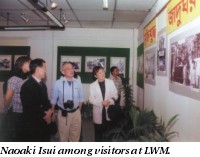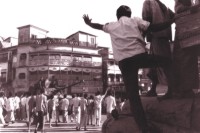| Victory
Revisited
Mustafa Zaman
 The
sudden emergence of a Japanese journalist with a series
of photographs showcasing the victory of this nation provides
a refresher course in history of the day after the nation
was declared free. The immediate reaction of the masses
in jubilation, flaunting flags and guns and chanting Joy
Bangla, were zealously caught frame by frame. It was sheer
luck that these photographs have resurfaced after 32 years.
Now they seem to have instigated in the collective consciousness
a sense of nostalgia as well as pride. In the face of present
political disillusionment, a glimpse into the heroic past
seems like a strong moral stimulus. The
sudden emergence of a Japanese journalist with a series
of photographs showcasing the victory of this nation provides
a refresher course in history of the day after the nation
was declared free. The immediate reaction of the masses
in jubilation, flaunting flags and guns and chanting Joy
Bangla, were zealously caught frame by frame. It was sheer
luck that these photographs have resurfaced after 32 years.
Now they seem to have instigated in the collective consciousness
a sense of nostalgia as well as pride. In the face of present
political disillusionment, a glimpse into the heroic past
seems like a strong moral stimulus.
Seen
through the lens of the camera of Naoaki Usui, a war correspondent
of Ryudo, a Japanese monthly magazine, the freshly freed
nation appears united and invincible. As a reporter, Usui
believes in "Representing the truth through camera,"
and his prints bear all the objectivity that brings back
the highs of the moment of pride in sharp focus. The pictures
were brought back from Japan after 32 years through the
joint initiative of the Muktijuddha Jadhughar (Libaration
War Museum) and the forum of Writers and Journalists of
Bangladesh in Japan.
Back
in 1971, Naoaki crossed the border of Bangladesh with the
advancing Mitrabahini, the alliance of Muktijoddhas and
the Indian army. "I did not even have a visa,"
Naoaki jokingly says remembering his first entry to independent
Bangladesh. It was a long emotionally streaked journey that
he embarked on December16. Starting from Kolkata, which
was his base during the war, he reached the Racecourse Maidan
of Khulna through Jessore on December 17. The 17 hour long
journey was an eye opener for him. It was also his "first
encounter with possible death as well as with the young
Bangalis in the throes of euphoria," he eloquently
remarks.
 On
his way and especially in Khulna, he witnessed the people
celebrating their hard-earned victory. "I did my homework
before coming to explore a nation that was soon to become
free," asserts Naoaki, who was moved by the chanting,
screaming mob. And he claims he understood what they were
saying. The reverberating "joy bangla", and other
slogans had their impact on him too. A foreigner in a new
land, Naoki was only 28 back then. On
his way and especially in Khulna, he witnessed the people
celebrating their hard-earned victory. "I did my homework
before coming to explore a nation that was soon to become
free," asserts Naoaki, who was moved by the chanting,
screaming mob. And he claims he understood what they were
saying. The reverberating "joy bangla", and other
slogans had their impact on him too. A foreigner in a new
land, Naoki was only 28 back then.
"It
was one of my important foreign assignments," revealed
Naoaki to the journalists who came to report on the exhibition.
Naoki's involvement gave birth to a body of work that has
stirred the imagination of many. Long dormant emotions were
whipped up by this sojourning Journalist.
It has
been two years since this historical treasure trove was
discovered. "We first came to know about Naoaki Usui
from young Bangladeshi people living in Japan. They have
a writer-journalist forum of which Monzurul Haq is the chief
advisor, it was Haq who brought the name of Naoaki out in
the open," says Mofidul Hoque, one of the trustees
of the Liberation War Museum (LWM).
Monjurul,
foreign correspondent for both the Daily Star and the Prothom
Alo, stumbled into Naoaki by pure chance. In 2001, while
attending a condolence meeting of another Japanese journalist
who had just passed away, Monjurul found out that Naoki
was a war correspondent who visited Bangladesh in 1971.
While his compatriot was working in the Kashmir front, Naoki
was assigned to cover the eastern zone, where after a nine
month long war a new nation emerged. " While addressing
the audience, Naoaki spoke of his posting in Kolkata and
his visit as a journalist to the newly liberated country
which made Monjurul Haq curious," reveals Mofidul Hoque.
The Liberation War Museum was waiting for an opportune moment
to bring Naoaki's works to Dhaka.
The
exhibition titled Amar Dekha Bijoy (victory seen through
my eyes) was inaugurated on December 10, at the premises
of LWM. "The show had a strong impact. To be frank
we did not even realise that this show would make such a
big wave in Dhaka," expresses Md. Maruf Hassan who
is the network engineer at LWM and he also worked as the
guide of Naoaki during his stay in Bangladesh.
 The
show took off on December 10, two days prior to the arrival
of Naoaki. The Bangladesh Writer's and Journalist's forum
in Japan raised the funds to sponsor Naoaki's visit, and
the rest was looked after by the LWM. The
show took off on December 10, two days prior to the arrival
of Naoaki. The Bangladesh Writer's and Journalist's forum
in Japan raised the funds to sponsor Naoaki's visit, and
the rest was looked after by the LWM.
The
show was part of the series of programmes taken up by LWM
on the occasion of Victory Day. The pictures of victorious
people, the joy and celebration, encapsulated in still snapshots
were the kind of documents that drew unprecedented attention
from the people. In the comment book kept at the exhibition,
a man from Khulna writes, "The pictures of Naoaki tapped
into my consciousness made me more aware of the spirit that
lied latent in me, and intensified my emotion regarding
the war of independence."
Taken
in Jessore and in Khulna on December 17, the pictures triggered
off many kinds of responses, most of which centred around
rehashing of memories and the sense of reclamation of the
spirit of '71.
"Photography
is strong media. You freeze one moment, a meaningful moment
that remains their forever," says Naoaki. The man who
wanted to be a pilot, Naoaki's plan was thwarted as he found
out that he was short sighted. "It meant that I would
never ever be able to become a pilot," remembers Naoki.
He was in junior high, and from that point on, he, "Started
to look forward to another exciting, active profession."
He was only 19, when he came across a book titled "Slightly
out of Focus" by Robart Capa. "He was a very well-known
war photographer during the second World War," informs
Naoky. Wrote in a hilarious mode, the book had a solid impact
on the impressionable mind. Naoaki did not specialise in
photography. In his opinion, "I wanted to report events
and people, so, technical precision was never my aspiration.
I was interested in people."
With
a major in French Culture, Naoaki now is a freelance journalist
and a consultant editor of the Science-News.
A well-known
journalist in Japan, his works have brought him at the centre
of Dhaka cognoscenti after this show, where 27 of his works
featured. Besides the exhibition, there were ancillary events
that provided Naoaki the opportunity to get in touch with
the people. During his stay in Dhaka, the LWM arranged for
a seminar on December 14, where he reminisced his days during
'71.
A visit
to village called Paril in Manikgang, 35 miles from Dhaka,
was one of the highlights of his stay. On Victory Day, he
met the Muktijoddhas of Paril who had fought throughout
the nine month long war. In October 19, 1971 they won a
sanguinary battle that left several boats full of Pak army
capsized. This event instigated retaliation on the part
of the Pak army, who later burned the surrounding villages.
For Naoaki as well as for the villagers, the visit to Paril
was an emotional occasion that brought him closer to the
heroes of the soil.
Prior
to the attending the function at Paril, in the morning of
December 16, he met with the children,
"For
them the pictures are the only opportunity to look at the
events of war, says Naoaki who seems inspired about children
and their interest in his work.
"I
am amazed how far this country has come since 1971,"
he says. After the devastation of the war he has witnessed
the healing process that began from December 17, 1971. That
was also the first time he was exposed to war.
Having
seen two different faces of Bangladesh, he goes on about
its people. "Healing is a strong word, a very psychological
word. What I had seen is a people in rejoice. Now in 2003
they seem much more resolved, much happier," adds Naoaki.
In the
exhibition comment book, a daughter of a Muktijoddha, expressed
her renewed belief in what her father fought for. Her understanding
was only augmented as she surveyed the works of Naoaki.
Her last comment was, "Looking at these pictures of
brave men, I was incessantly reminded of one and only thingwhy
was I not born before so that I too could fight for our
freedom."
|

 The
sudden emergence of a Japanese journalist with a series
of photographs showcasing the victory of this nation provides
a refresher course in history of the day after the nation
was declared free. The immediate reaction of the masses
in jubilation, flaunting flags and guns and chanting Joy
Bangla, were zealously caught frame by frame. It was sheer
luck that these photographs have resurfaced after 32 years.
Now they seem to have instigated in the collective consciousness
a sense of nostalgia as well as pride. In the face of present
political disillusionment, a glimpse into the heroic past
seems like a strong moral stimulus.
The
sudden emergence of a Japanese journalist with a series
of photographs showcasing the victory of this nation provides
a refresher course in history of the day after the nation
was declared free. The immediate reaction of the masses
in jubilation, flaunting flags and guns and chanting Joy
Bangla, were zealously caught frame by frame. It was sheer
luck that these photographs have resurfaced after 32 years.
Now they seem to have instigated in the collective consciousness
a sense of nostalgia as well as pride. In the face of present
political disillusionment, a glimpse into the heroic past
seems like a strong moral stimulus. On
his way and especially in Khulna, he witnessed the people
celebrating their hard-earned victory. "I did my homework
before coming to explore a nation that was soon to become
free," asserts Naoaki, who was moved by the chanting,
screaming mob. And he claims he understood what they were
saying. The reverberating "joy bangla", and other
slogans had their impact on him too. A foreigner in a new
land, Naoki was only 28 back then.
On
his way and especially in Khulna, he witnessed the people
celebrating their hard-earned victory. "I did my homework
before coming to explore a nation that was soon to become
free," asserts Naoaki, who was moved by the chanting,
screaming mob. And he claims he understood what they were
saying. The reverberating "joy bangla", and other
slogans had their impact on him too. A foreigner in a new
land, Naoki was only 28 back then.  The
show took off on December 10, two days prior to the arrival
of Naoaki. The Bangladesh Writer's and Journalist's forum
in Japan raised the funds to sponsor Naoaki's visit, and
the rest was looked after by the LWM.
The
show took off on December 10, two days prior to the arrival
of Naoaki. The Bangladesh Writer's and Journalist's forum
in Japan raised the funds to sponsor Naoaki's visit, and
the rest was looked after by the LWM.